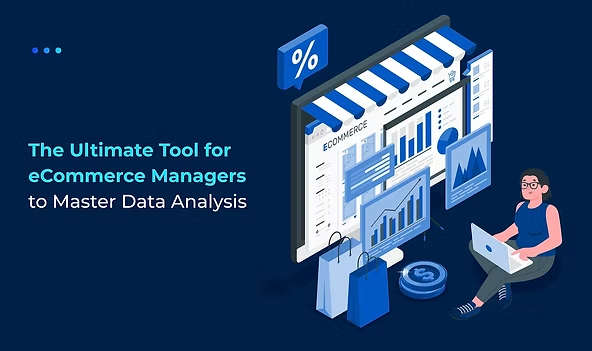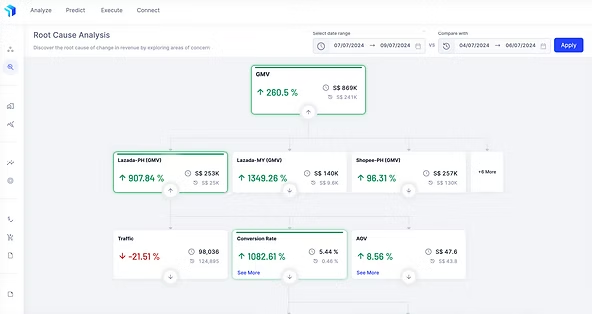
If your yearly revenue is lagging behind other eCommerce businesses in the same industry, you need a strategy to meet or exceed the industry benchmark.
A common issue in eCommerce is the false sense of growth—businesses often believe they are succeeding simply because their revenue is increasing. However, if the industry is growing by 20% per annum while your growth is only 6%, you're falling behind.
If you’re an eCommerce manager, you should know that beating the benchmark requires more than gut instinct; it demands data-backed decisions.
In this blog, we’ll discuss how eCommerce managers can use Graas to manage and analyze their data, ensuring they not only meet but surpass industry standards.
Let’s dive right in.
Effective data management is crucial for eCommerce businesses striving to stay competitive and achieve growth.
However, several common pitfalls can affect data management efforts and, consequently, business performance. Understanding these challenges is the first step towards addressing them.
One of the most significant challenges in eCommerce data management is the lack of data integration. eCommerce businesses typically sell across multiple channels, such as Amazon, Flipkart, Lazada, Shopee, and their own websites.
Each of these channels generates its own set of sales reports and data. This means that eCommerce managers often have to log into multiple seller accounts, download sales reports, and then manually consolidate this data. This process is not only time-consuming but also prone to errors.
The inefficiency of logging into various accounts, downloading reports, and attempting to merge disparate data sources can lead to delays in analysis and decision-making. Without a unified view of sales performance across all channels, it becomes difficult to get an accurate picture of overall business health. This fragmentation can result in missed opportunities and suboptimal strategies.
Even when eCommerce managers manage to regularly collate data from various channels, they often face the issue of inaccurate or incomplete data collection.
One of the primary reasons for this is the inconsistency in how different channels provide their reports.
When data comes in various formats and structures, eCommerce managers spend a significant amount of time cleaning and organizing it. This makes the task a lot more taxing and makes it challenging for eCommerce managers to make complete sense of their data.
This additional workload not only delays insights but also increases the chances of errors, making it difficult to rely on the data for decision-making.
Data quality and cleanliness are crucial for accurate analysis. However, eCommerce data is often heterogeneous, coming from multiple sources with different metrics and calculations.
For example, some channels measure revenue as the total revenue generated, while others subtract cancelled orders from the total revenue. Moreover, the timing of revenue recognition can also vary across channels. Some may record revenue at the point of sale, while others might wait until the product is shipped.
These discrepancies in revenue calculation and timing can lead to misleading insights by creating an uneven playing field for comparison.
A channel that subtracts cancelled orders might appear to underperform compared to one that doesn't, even if their actual performance is similar. Similarly, channels recognizing revenue at different times may show artificial peaks or troughs in performance that don't reflect real differences in effectiveness.
Without accounting for these variations, eCommerce managers may make flawed decisions, such as reallocating resources away from actually effective channels or failing to address real issues masked by inconsistent measurement practices.
Relying on manual data analysis significantly slows down the decision-making process. When data needs to be manually collected, cleaned, and analyzed, there are inevitable delays. These delays mean that by the time the data is ready for analysis, the insights it provides may no longer be relevant.
For example, an eCommerce manager might identify a trend or issue in the data, but if this insight comes a week late due to manual processing, the opportunity to act on it effectively might have passed. This lag in decision-making can put the business at a competitive disadvantage
In the next section, we will discuss how Graas can help overcome these challenges and provide actionable insights for better eCommerce performance.
Graas is an eCommerce platform designed to help managers overcome the common pitfalls of data and get advanced insights.
By using its advanced analytics, managers can streamline their processes, gain valuable insights, and make data-driven decisions that drive growth and profitability.
Here’s how Graas eCommerce analytics can help:
One of the primary advantages of Graas’ advanced analytics is its ability to consolidate data from multiple sources.
Instead of manually logging into various seller accounts and downloading sales reports, eCommerce managers can access all their data in one unified dashboard.
Graas integrates seamlessly with major eCommerce channels like Amazon, Flipkart, Lazada, Shopee, and others, providing a comprehensive view of sales performance across all channels.
This consolidation eliminates the inefficiencies and errors associated with manual data merging. With all data in one place, managers can easily track overall business performance, compare metrics across different channels and products, and quickly identify trends and anomalies.
Graas accelerates the decision-making process by automating data collection and analysis. With real-time access to consolidated and cleaned data, eCommerce managers can make informed decisions much faster.
The platform provides various analytical views, such as Difference, Proportion, Trend, and Currency views, allowing managers to analyze performance data from different perspectives.
By reducing the time spent on manual data handling and analysis, managers can focus on strategic decision-making. This agility is crucial in eCommerce, where market conditions and consumer behaviors can change rapidly. Faster decision-making allows businesses to respond quickly to opportunities and challenges, maintaining a competitive edge.
Effective inventory and product management are essential for optimizing eCommerce performance. Graas offers robust eCommerce inventory analytics and product insights that help managers track inventory levels, identify best-selling and underperforming products, and optimize stock levels to meet demand.
By analyzing detailed metrics such as revenue per product, sales velocity, and inventory turnover rates, managers can make data-driven decisions about product promotions, restocking, and discontinuation. This helps minimize stockouts and overstock situations, reducing holding costs and ensuring that high-demand products are always available for customers.
Graas’ advanced analytics goes beyond basic analytics by providing actionable insights and recommendations. The platform offers deep insights into various business metrics, such as revenue, traffic, conversion rates, and average order values (AOV). These metrics are further divided to give you granular insights. For example, under AOV, you can see Revenue Per Buyer, Sales Per Buyers, and Items Per Order.
Moreover, Graas provides tailored recommendations based on the identified trends and patterns. Managers can conduct data-backed experiments to test different strategies and see what works best for their business. Whether it's optimizing product pages or adjusting pricing strategies, the recommendations help in implementing effective changes.
This approach to experimentation ensures that decisions are not based on gut feelings but on solid data and analysis. By following these recommendations, eCommerce managers can continuously improve their strategies and achieve better results.
Trend analysis and forecasting are crucial for anticipating market shifts and preparing for future demands.
Graas allows eCommerce managers to examine historical data to identify patterns and trends. By understanding past performance, eCommerce managers can run predictive analytics with greater accuracy.
This capability is particularly useful for planning marketing campaigns, inventory purchases, and budget allocations. For example, if a particular product sees a spike in sales during a specific season, managers can increase inventory and marketing efforts in anticipation of this trend.
Forecasting helps in proactive decision-making, ensuring that the business is well-prepared to meet customer demands and capitalize on upcoming opportunities.
Graas Business Deep Dive allows eCommerce managers to perform detailed comparative analysis across different time periods, channels, and products. This feature allows managers to compare current performance with past results to identify growth trends and areas for improvement.
For example, managers can analyze sales data from different months or years to see how performance has changed. They can also compare the effectiveness of different sales channels or the performance of various products.
This comparative analysis helps in understanding the success of past strategies, identifying which areas are performing well, and pinpointing where changes are needed. By using these insights, managers can optimize future actions to enhance overall performance.
Understanding the root cause of eCommerce performance issues is essential for making informed decisions. Graas provides tools for root cause analysis, allowing managers to dive deep into the data to find the “why” behind behind performance trends.
Whether it's a sudden dip in sales, a spike in returns, or a drop in traffic, managers can look at the specific metrics that contribute to these changes.

By identifying the root causes, eCommerce managers can address issues more effectively and, more importantly, think about targeted solutions that directly tackle the problem.
For example, if a drop in sales is linked to a specific product category, managers can review and revise their inventory, marketing, or pricing strategies for that category.
This focused approach ensures that efforts are directed where they are most needed, leading to more effective problem-solving and sustained business growth.
Are you an eCommerce manager or business owner looking to analyze and improve the performance of your business? Graas’ advanced analytics is for you. Data from all the channels are consolidated in one dashboard with recommendations and insights to improve performance — and more!